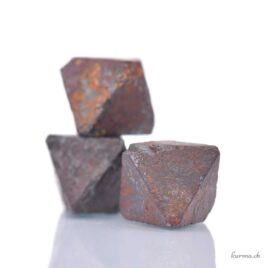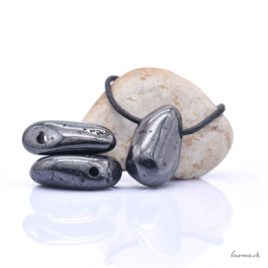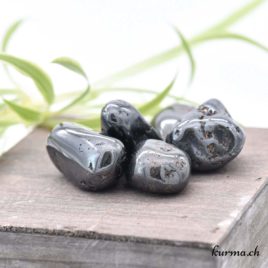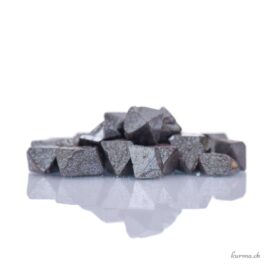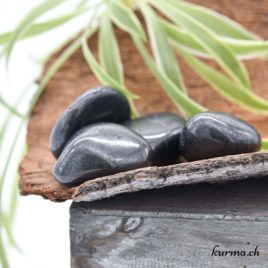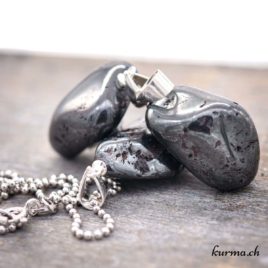Magnetite - Magnet stone
rough, minerals, rolled stones, pendants
A natural magnet in its raw form, Magnetite is an iron oxide.
In lithotherapy, its properties of anchoring, protecting and rebalancing energies can help you follow your path without going astray.
What are the properties and benefits of Magnetite in lithotherapy?
Symbols
Magnetite is a naturally magnetized iron oxide.
Flolklore has it that while climbing Mount Ida in Crete, a shepherd named Magnes discovered this stone stuck to the metal nails of his shoes.
Magnetite was first mentioned by Thales of Miletus in the 6th century BC. Aristotle and other Greek philosophers wrote that these stones have a soul because they can attract and move iron.
Magnetite is one of the oldest minerals in human history - Egyptians and Sumerians discovered its magnetic properties over 6,000 years ago.
In ancient China, pieces of magnetite suspended on wires were used as rudimentary compasses as early as 300 BC. The first compass was created by Hanfucio 2500 years ago. It was designed to point only south (north was considered to bring bad luck). Geomancers used it as a guide to areas suitable for construction and cultivation.
It would appear that the Olmecs in Central America used magnetic needles long before the Chinese, around 1000 BC, but the ultimate proof of this remains to be found.
In Europe, it wasn't until the 1100s that the first compasses appeared.
In her writings, Hildegarde de Binden prescribes it as a medium for telluric forces to combat madness. For her, Magnetite was born from the mixture, on iron ore, of the saliva of venomous snakes living in sand and the venom of a snake living in or near water.
Contemporary esoteric traditions regard Magnetite as a manifestation stone (see below) attracting love, prosperity and protection.
It is also associated with vitality and resistance.
Its meaning and spiritual virtues in lithotherapy
A demonstration stone
In lithotherapy, a manifestation stone is a stone that helps to realize intentions, desires or goals.
The special energy of these stones can amplify thought, visualization and willpower.
Like stones such as Citrine (attracting abundance and success), Pyrite (prosperity and confidence) or Clear Quartz (amplifying every intention), Magnetite helps to strengthen attraction and willpower.
To help bring a project or wish to fruition, it is used in intention rituals, in crystal grids, by wearing it on oneself, on an altar and during meditation, all with the aim of aligning personal energy with that of the universe.
What does it mean?
Magnetite is a symbol of irresistible attraction.
Benefits
Strongly linked to the root chakra, to a connection to the Earth, Magnetite will be the perfect adjuvant for and in search of emotional stability, seeking to refocus and quench scattered thoughts. It can then be the presence and the tool that will encourage you to rediscover inner balance and security.
Stone soothes anxiety and raw stress. By calming mental tensions, it brings relief, like a call to reconcile opposites.
The naturally magnetized stone is not a balm, but a vitality booster. Its symbol expresses the ultimate physical force in its representation: a stone that attracts iron!
Circulation, stamina, strength: the energies that accompany the stone can strengthen and rebalance you.
Its protection, in lithotherapy, will be a call to balanced and thoughtful action. The manifestation stone attracts positive energies, which can translate into a newly sensitive and attentive eye for new opportunities, and which, by the grace of movement, in turn creates attraction.
Tradition makes it a guide to your own ideals, helping you to identify your resources and avoid getting lost; inviting you to a critical overview, perhaps itself carrying the seeds of a sorting out of what you choose to keep on your path.
What are its physical properties?
The physical effects of magnetite have not been established by science. In lithotherapy, tradition attributes it with stimulating the flow of energy in the body. It is said to promote hormonal balance, relieve pain and reduce iron deficiency.
Caution! Because of its magnetism, people with pacemakers should not wear this stone.
How to use Magnetite
- To clarify your thoughts, place the stone on your forehead during relaxation or meditation.
- in case of pain (joint, muscle, inflammatory), place it directly on the affected area. Don't hesitate to use a bandage to hold it in place.
- keep a Magnetite on you: if you feel lost, have to make a choice or don't yet know what direction to take in your life.
- A hematite or micaceous iron will strengthen the anchorage and protection of the magnetite.
- Obsidian or volcanic glass will support the release of consequent emotional blockages
- Transparent Smoky Quartz promotes clarity of thought and protection from negative influences.
What stones and crystals should Magnetite be associated with?
To amplify its benefits in lithotherapy, you can combine Magnetite with complementary stones:
Refilling and cleaning
How to purify Magnetite?
Under the Full Moon / waveform (flowers of life or sacred geometries) / fumigation (incense, white sage or palo santo between 30 and 60 seconds) / singing bowl, Tibetan bells or tuning fork, natural breath/wind / intentionCare to avoid
Avoid salt water or soaking.
Chakras
Root chakra (Muladhara)main action: anchoring, stability, inner security
Heart chakra (Anahata)
emotional healing, openness, balance
Third eye (Ajna) chakra
enhanced intuition, mental clarity
Astrological signs
Capricorn, Virgo, Taurus, Aquarius, Ariesstable and protective energy
Element
Earthanchoring and structure
Magnetite mineralogy
Magnetite, a member of the spinel group, is an iron oxide containing aluminum, magnesium, cobalt, chromium, nickel, titanium and vanadium.
It is formed in liquid magma, from magnetic gases, with bubbling aqueous solutions, or by metamorphism when pressure and heat transform iron ore.
With its cubic crystalline system, it comes in the form of small octahedron or rombodecahedron crystals measuring a few millimeters to a few centimeters, or in the form of a rough compact mass.
Its color ranges from dark gray to black, its appearance is matte and its surface is generally granular and fissured, or smooth with a submetallic sheen.
Also known as magnet stone, this natural magnet derives its magnetism from its cubic structure, thanks to which the iron ions can be arranged in such a way that all the magnetic poles of the individual particles point in the same direction, to form a magnetic field that gives Magnetite, in its raw form, the power to attract iron filings.
Magnetite has a hardness of 5.5 to 6.5 on the Mohs scale. It is a moderately hard stone.
Caution! It's not uncommon to find jewels and cabochons labelled Magnetite that are actually magnetized iron.
Did you know?
When Magnetite is heated to 580° its magnetism disappears - and returns when the stone has cooled.
Lithotherapy
- Element(s) :
- Zodiac(s) :
- Capricorn, Aquarius
- Purification :
- Singing bowl, Water, Fumigation, Moon, Form waves, Sun, Breath, Earth
- Physics :
- Anemia
- Emotional :
- Action
- Spiritual :
- Alignment, Anchoring
- Miscellaneous :
- Relationship (friendship), Relationship (love), Relationship (family)
Mineralogy
- Hardness :
- 5.5
- Moths scale:
- 5
- Strunz classification :
- Oxides and Hydroxides
- Crystalline system :
- Cubic
- Chemical element :
- Fe, O
- Line color :
- Black
- Density :
- 5.2
- Cleavage :
- Partial on {111}
- Fracture:
- Irregular, subconchoidal
- Transparency :
- Opaque
- Fluorescence :
- No
- Colors :
- Metallic, bold, matt
- Magnetism :
- yes
- Radioactivity :
- no
Other stones for pain relief
*Please note! Some minerals may be toxic and must not be licked or ingested (as such or in the form of powder, elixir or stone water) or be in prolonged contact with the skin or mucous membranes.
*The information on the stones described here are general indications based on our research and experience, and are not exhaustive.
Reproduction in whole or in part of this content is prohibited. More info


